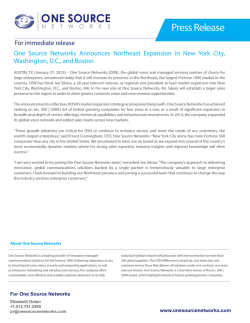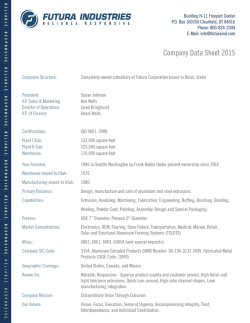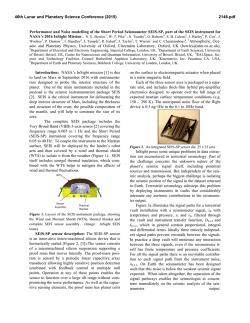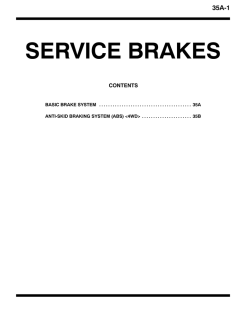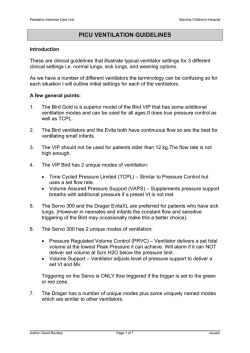
Brochure, Electromechanical NC Joining Systems
Electromechanical NC Joining Systems Flexible Solutions for Your Application Electromechanical NC Joining Systems For joining and press-fit applications, electromechanical NC joining systems are increasingly replacing the familiar hydraulic, pneumohydraulic or pneumatic joining modules and actuator. In addition to reduced environmental impact, a more favorable energy balance, compact design, ease of installation and very low-maintenance operation, it is typically production advantages that make an electromechanical system the obvious choice for the system designer. These include flexibility, exact postioning, extremely high repeatability and accurately defined joining forces. The XY monitor maXYmos NC Type 5847A... not only handles the evaluation of curve progressions and their documentation, it is also responsible for actuating the servo amplifier IndraDrive controlling the NC joining module. Communication takes place in real-time through SERCOS III, guaranteeing high repeatability and maximum performance in process control. Commissioning is easy via PC or by using the optional touch screen. Various fieldbus interfaces are available to connect to the control system. The integrated sequence control (sequencer) makes for easy, fast and versatile mapping of even complex processes. The monitor, which is cascadable to up to eight XY channel pairs, designed primarily for the sophisticated user, leaving nothing more to be desired with respect to application management, operating convenience and flexibility. Aided by a multitude of high-performance evaluation elements, even very complex XY sequences can be monitored and controlled. For data export, the process data is transferred via the Ethernet interface using Q-DAS®, CSV, PDF, XML or is made ready at the fieldbus. NCFT Type 2157B… NC joining module with integral piezoelectric force sensor with measuring ranges from 0,05 ... 1,5 kN. • Suitable for applications in clean room, e.g. in manufacturing of medi- cal technology consumer products • Force signal is transmitted via telemetry for highest measuring precision At a Glance Electromechanical NC joining systems offer considerable advantages over conventional technologies, such as hydraulics or pneumatics. NCFH Type 2151B… NC joining modules with space-saving, gearless, hollow-shaft motor and integral piezoelectric force sensor. The measuring ranges are dependant on module sizes 1 … 60 kN. • Short design, 2 sizes • High speed • Dynamic processes NCFS Type 2152B… NC joining module with internal piezoelectric force sensor and two predefined measuring ranges of 25 and 15 kN. • Particularly slim design allows closely spaced individual workstations • More accurate guidance • Particularly rigid • Use in automated production facilities Services + Worldwide support with startup + Global calibration service + Process and cycle time optimization + Maintenance contracts + Testing of customer samples NCFB Type 2160A… NC joining module with integral piezoelectric force sensor and two predefined measuring ranges of 5, 15 and 25, 50 kN. • Reasonably priced • Rugged design • Ideal for standard joining processes NCFN Type 2153A… NC joining modules with integral strain gage force sensor for nominal joining forces of 5, 10, 15, 30, 60, 100, 200 and 300 kN. • Use in automated production facili ties and manually controlled workstations • Optional safety brake • Several strokes available The NC Joining Modules NCFT, NCFH, NCFS and NCFB Utilize an Integral Piezoelectric Force Sensor that Offers: + Measuring range switching, which is ideal for applications such as mixed production, and avoids having to preset the correct force measuring range + Cuts spare parts inventory and design costs + Overload protection and more rigid force sensor Custom design upon request. Q-DAS® is a registered trademark of Q-DAS GmbH & Co. KG. 2 www.kistler.com Overview NC Joining Modules Measuring Range 0,01 kN 0,1 kN 1 kN 10 kN 100 kN 1 000 kN Stroke 0 mm 50 mm 100 mm 200 mm 300 mm 400 mm Max. speed 0 mm/s 50 mm/s 0,05 100 mm/s 0,25 0,5 1 NCFT NCFT Type 2157B... -Measuring direction: tension/compression -Piezoelectric force sensor -With holding brake 0,1 200 mm/s 1,5 300 mm/s Measuring range switching to either 0,05 / 0,1 / 0,25 / 0,5 kN Transmission force signal from RAM via telemetry for highest measuring precision 100 mm 400 mm/s Certified for class 8 clean room use (7 possible) 1 2 5 10 15 NCFH NCFH Type 2151B... Size 1 -Measuring direction: tension/compression -Piezoelectric force sensor - With holding brake Measuring range switching to either 1, 2, 5 kN 200 mm NCFH 300 mm/s 15 30 NCFH 60 Measuring range switching to either 15 or 30 kN 400 mm NCFH Type 2151B... Size 2 300 mm/s 15 NCFS 25 Measuring range switching to 15 kN 350 mm NCFS Type 2152B... -Measuring direction: tension/compression - Piezoelectric force sensor 250 mm/s 5 15 NCFB Measuring range switching to 5 kN 25 NCFB Type 2160A... -Measuring direction: compression -Piezoelectric force sensor -Option holding brake 400 mm/s 50 NCFB Measuring range switching to 25 kN 400 mm at 15 kN, 200 mm 150 mm/s Depending on size 250 mm/s 5 NCFN 10 NCFN 15 NCFN Option: safety brake (holding brake omitted) safety features and equipment in servo controller 30 NCFN NCFN Type 2153A... 60 NCFN 100 NCFN -Measuring direction: tension/compression -DMS force sensor -With holding brake 200 NCFN 300 NCFN at ≤100 kN, 200 mm 100 Depending on size 140 400 mm 200 250 250 mm/s Note: Each NC joining module utilizes an integral absolute encoder for positioning. See the corresponding data sheet for additional technical data. www.kistler.com3 Overview with Typical System Configuration and Main Features System setup for complex force-displacement evaluation and documentation with maXYmos NC PROFIBUS PROFINET EtherNet /IP EtherCAT NC joining module NCFH Type 2151B... Absolute encoder Analog force signal Measurement range switch KSM18028884-5 AC servo motor safety zone box Machine interface PLC Nominal value/actual value commands OK/NOK Servo amplifier IndraDrive MEM DIM Threaded spindle drive Charge amplifier Piezoelectric force sensor Cable safety zone box KSM18029161-1 SERCOS III KSM18029160-5 Motor control feedback Cable 1200A161A... (Cable length max. 5 m) Configuration, parameterization, evaluation and visualization maXYmos NC Type 5847A... PC Ethernet interface CSV, Q-DAS®, PDF, XML, Visualization via VNC® Functional principle of an NC joining system using the NC joining module NCFH Type 2151B... and maXYmos NC Type 5847A... Sequencer - for better flexibility The maXYmos NC controls the NC joining module, via the servo amplifier, through the integrated sequence control (sequencer). An independent sequence can be defined for each program. The sequence can be configured freely on the basis of the elements described below. Measurement and evaluation take place in the main routine. The 3 subroutines can be used to define other sequences and execute these independently of the main routine. A total of 255 elements can be placed per program. Motion Element Controls the NC joining module process Measurement Start/Stop Element Defines the measurement sequence Timer Element Defines a delay time (e.g. setting time) Dialog Element Defines an interaction via the display Calculation Element Performs calculations Input Element Reacts to the status of a digital input Output Element Sets a digital output Wait Element Defines a stop in the sequence chain Label Element Defines a label (mark) 4www.kistler.com Excerpt of the evaluation elements EOs (Evaluation Objects) for maXYmos NC Type BREAK Type HYSTERESIS-X Provides NOK and online signal in case of sudden gradient change within an expectancy range (box), e.g. in case of tool breakage. Type AVERAGE Evaluates the X-hysteresis between forward and reverse curves on a horizontal line. Type GRADIENT-X Evaluates the average of all Y-values in the box region. Type GET-REF Evaluates the gradient dX/dY between two horizontal lines. Type CALC X1 Type SPEED Evaluation criterion is the speed between the entry and exit points in a special box. Type TIME Evaluation criterion is the time between the entry and exit points in a special box. Type INTEGRAL X2 Y2 Y1 Box detects significant curve features and their XY coordinates in the expectancy range. This information can be used as reference points for other EOs or as an input for the CALC object. Type TUNNELBOX-X IO Object references two selectable process values and performs calculations, e.g. the X-difference between two ripples, and evaluates them. Type INFLEXION The area beneath the curve is determined and evaluated. Type ENVELOPE CURVE NIO Entry and exit as specified. Crossing of the "closed" sides generates a real-time signal. Type LINE-X The line must be crossed once. An X-value at the point of intersection is monitored. A defined gradient change is expected within the expectancy range (box) and can be used as a further switching condition in the sequence. Type NO-PASS The line may not be crossed. Otherwise, NOK and "NO-PASS" real-time signal. The measurement curve must not cross the upper or lower line of the envelope. This evaluation object is easy to master. Type UNI BOX Entry and exit as specified. No crossing of "closed" sides allowed. Each side can be defined as entry or exit. www.kistler.com5 Technical Data maXYmos NC XY monitor maXYmos NC Type XY monitor maXYmos NC 5847A... UNI BOX (window) 1 x XY LINE (X + Y) Expandable up to measurement channels 8 x XY ENVELOPE (envelope curves) NO-PASS HYSTERESIS (X + Y) GRADIENT (X + Y) AVERAGE (average value BOX) CALC (calculates and evaluates) INTEGRAL GET-REF (finds reference point) SPEED Functions of measurement curve detection Storage depth per measured curve Sample rate (XY value pairs/second) y = f(x), y = f(t), y = f(x, t), x = f(t) 8 000 * XY 10 000 Number of parameter sets per XY channel 128 Motion elements for evaluating curve progression Number of measurement channels / basic unit Servo (SERCOS III) Incremental SSI Voltage ±10 V BREAK LVTD INFLEXION Potentiometer TUNNELBOX (X + Y) Piezo Ethernet (TCP/IP) DMS Voltage ±10 V 10,4" Remote control via Ethernet per VNC Power 24 (18 ... 30) VDC Fieldbus Sensor channel X Colour touch screen Interface 500 curves Sensor channel X Diagnosis storage for measured curves USB (Host + Device) PROFIBUS DP PROFINET EtherNet/IP EtherCAT Application Examples Appendix 1: Press-fitting an angular contact ball bearing with an NCFN Type 2153A60400. In this station, an angular contact ball bearing is joined at a certain angle with great force and high precision. The plunger extends outward 374 mm and must then flush-join an angular contact ball bearing with up to 53 kN. Appendix 1: Preassembly of intermediate housing for the gearbox assembly Appendix 2: Press-fitting/joining of various roller bearings and ball bearings into the gearbox housing Appendix 2: Eight compact NC joining modules NCFH Type 2151B60304002 are used in the station. A wide variety of joining operations can be performed simultaneously in the station. With force and path monitoring from Kistler, the end-user can ensure that the safety-relevant parts are installed in the gearbox according to specifications. 6www.kistler.com Application Examples Joining of elastomer supports in tracking stabilization bars In this machine the NC joining module model NCFN Type 2153A..., 60 kN is used with a cycle time of 15 seconds; fully automatic with bearing feeding and part recognition. 20 different variants are available. Riveting machine for lightweight brake disk The model NCFN Type 2153A... is used in this machine allows for riveting of up to 20 different types of lightweight brake disks. The light aluminum pot allows weight savings of up to 3 kg per vehicle axle depending on size. Process • The aluminum pot is heated inductively and joined to the brake disk • The resulting composite assembly is drilled with 18 holes and then riveted Wheel carrier assembly Work Sequence • Mount receptacle and roller burnishing tool for joint • Insert pre-mounted joint manually • Plausibility check with camera (various types) • Automatic press-fit of rubber bearings into tie rod eye (approx. 20 kN) flush-joining • Robot hands over to spring control arm eye in press-fit station 2 Other typical joining and press-fit applications, including vehicle wheel carriers • Procedure "Insert joint manually" and "Press-fit rubber bearing" are repeated Process • Screw wheel carrier together • Robot places part on transport belt • Press-fit wheel flange The force/path evaluation for the monitoring of joining and press-fitting procedures is performed in this process by the force/path measurement device from Kistler. • Press-fit supporting joint and bushing Wheel carrier without struts Elastomer bearing Ball joint www.kistler.com7 ©2014, Kistler Group Wirxxxxx 300-614e-08.14 Kistler Group Eulachstrasse 22 8408 Winterthur Switzerland Tel. +41 52 224 11 11 www.kistler.com Offices in Europe, Asia, Americas, Australia
© Copyright 2025
